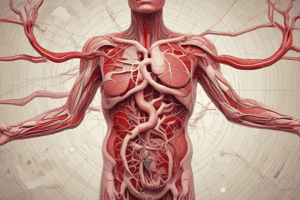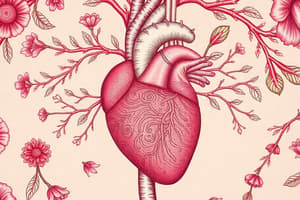Podcast
Questions and Answers
What are the two types of circulations in the cardiovascular system?
What are the two types of circulations in the cardiovascular system?
Greater (Systemic) Circulation and Lesser (Pulmonary) Circulation
What is the distribution of the cardiac output between the two circulations?
What is the distribution of the cardiac output between the two circulations?
The cardiac output is distributed between the greater (systemic) circulation and the lesser (pulmonary) circulation
What are the autonomic controls of cardiovascular system functions?
What are the autonomic controls of cardiovascular system functions?
Sympathetic and Parasympathetic
What is the action of sympathetic receptors on the SA node?
What is the action of sympathetic receptors on the SA node?
What is the action of parasympathetic receptors on the SA node?
What is the action of parasympathetic receptors on the SA node?
What is the action of sympathetic receptors on AV nodal conduction?
What is the action of sympathetic receptors on AV nodal conduction?
What is the action of parasympathetic receptors on AV nodal conduction?
What is the action of parasympathetic receptors on AV nodal conduction?
What is the action of sympathetic receptors on contractility?
What is the action of sympathetic receptors on contractility?
What is the action of parasympathetic receptors on contractility?
What is the action of parasympathetic receptors on contractility?
What is the role of intercalated discs in cardiac muscle function?
What is the role of intercalated discs in cardiac muscle function?
What are the main functions of the cardiovascular system?
What are the main functions of the cardiovascular system?
How does the functional organization of the heart and blood vessels help in maintaining cardiovascular functions?
How does the functional organization of the heart and blood vessels help in maintaining cardiovascular functions?
What are the components of the cardiovascular system?
What are the components of the cardiovascular system?
What are the three types of blood vessels?
What are the three types of blood vessels?
What are the special tissues in the heart responsible for generating and transmitting cardiac impulses?
What are the special tissues in the heart responsible for generating and transmitting cardiac impulses?
What is the function of fibrous tissues in the heart?
What is the function of fibrous tissues in the heart?
What is the difference between endocardium and pericardium?
What is the difference between endocardium and pericardium?
What is the functional importance of pre-capillary sphincters?
What is the functional importance of pre-capillary sphincters?
What substances are transported by the cardiovascular system?
What substances are transported by the cardiovascular system?
What maintains the unidirectional flow of blood in the cardiovascular system?
What maintains the unidirectional flow of blood in the cardiovascular system?
Name two factors that influence rhythmicity in the heart and explain their effects on chronotropic activity.
Name two factors that influence rhythmicity in the heart and explain their effects on chronotropic activity.
What is excitability in cardiac muscle and how does it differ from pacemakers?
What is excitability in cardiac muscle and how does it differ from pacemakers?
What are the differences between nerve and cardiac muscle action potentials?
What are the differences between nerve and cardiac muscle action potentials?
What are the differences between pacemaker and cardiac muscle action potentials?
What are the differences between pacemaker and cardiac muscle action potentials?
What are the absolute and relative refractory periods in cardiac muscle action potentials?
What are the absolute and relative refractory periods in cardiac muscle action potentials?
What are the factors that affect cardiac excitability?
What are the factors that affect cardiac excitability?
What are the different conducting tracts and nodes in the heart and their conduction velocities?
What are the different conducting tracts and nodes in the heart and their conduction velocities?
What is vagal tone and how does it affect heart rate?
What is vagal tone and how does it affect heart rate?
What are the factors that affect the conducting system of the heart?
What are the factors that affect the conducting system of the heart?
Flashcards are hidden until you start studying




